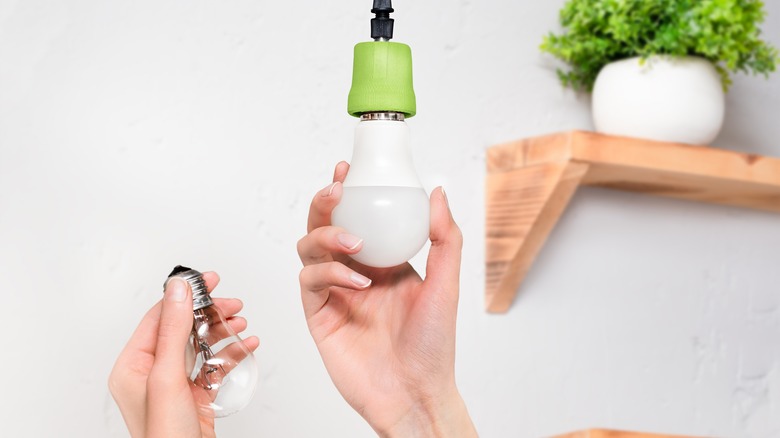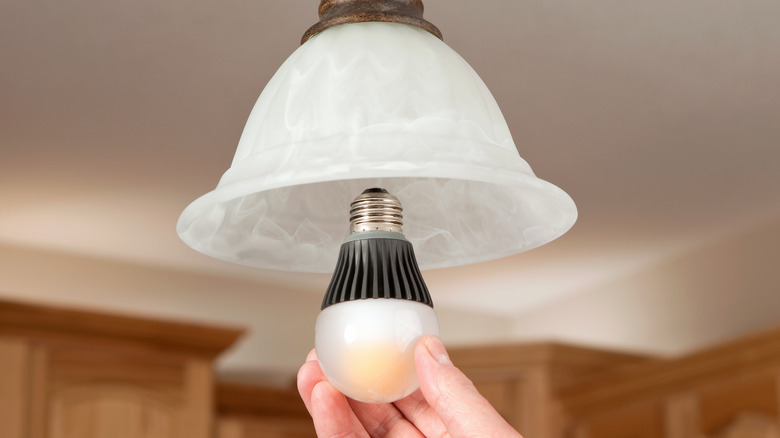Use The Property Brothers' Smart Advice For Hard To Reach Light Fixtures
When a light bulb goes out in a hard-to-reach fixture, homeowners are left to scramble to locate a tall ladder to replace the bulb. This turns what should be a simple task to maintain your home into a time-consuming chore. Property Brother Jonathan Scott revealed that you can use LED bulbs in these fixtures to simplify this problem. On an episode of "The Punch List," Scott shared that LED bulbs only need to be replaced every 10 years.
By upgrading old light bulbs to LEDs, homeowners do not need to worry about tracking down a ladder to replace bulbs in out-of-reach fixtures so frequently. LED bulbs typically last around 25,000 to 50,000 hours in total. In comparison, incandescent bulbs last about 750 to 2,000 hours before they need to be replaced. Halogen bulbs go out after anywhere from 2,000 to 4,000 hours. Fluorescent bulbs maintain power for approximately 10,000 to 60,000 hours. LED bulbs are clearly the winner for those with hard-to-reach light fixtures.
You do not have to replace LED bulbs as often
Jonathan Scott shared his LED bulb tip with a homeowner featured on "The Punch List" who was really struggling with her hard-to-reach light fixtures. It seems that they were quite the challenge for her because she left light bulbs in the fixtures that had long since stopped working. The homeowner simply could not reach the bulbs to replace them. With her new LED bulbs, she has about a decade left before she is due for a replacement.
By now, you might be tempted to replace your existing fluorescent light fixture with LED bulbs in those hard-to-reach spots throughout your home. If you searched LED bulbs online, you may have noticed that they cost a bit more than other light bulb types. Although they are a larger upfront investment, these bulbs will help you save money in the long run. This is thanks to the energy efficiency of LED bulbs. They use about 12 kilowatt-hours of electricity every 1,000 hours. Meanwhile, incandescent bulbs use about 60 kilowatt-hours (kWh) of electricity every 1,000 hours. As a result, LED bulbs can help lower your electricity bill.
Other benefits of LED bulbs
Electricity savings and energy efficiency are just a few of the many benefits of LED bulbs. At this point, you already know that they do not need to be replaced often and make maintaining hard-to-reach light fixtures less of a headache. Unlike incandescent lights, LEDs do not present the risk of burning you through infrared heat-radiated heat emission. They are also perfect to use in cold environments, like refrigerators. Fluorescent lights need more power to function in low temperatures, whereas LED bulbs thrive in the cold. If you have a newer refrigerator, take a look at the lighting inside of it. It likely contains LEDs.
To make replacing light bulbs in high ceilings a less frequent event along with the rest of these benefits, you can snag LED bulbs in-store or online. You might want to head to Amazon to purchase a large pack of bulbs if you need to replace multiple lights throughout your home. Before shopping, make note of the type of LED light bulbs you need for each fixture in your home. For example, you might prefer soft white lighting in your living room, and daylight white lighting in your bathroom.


